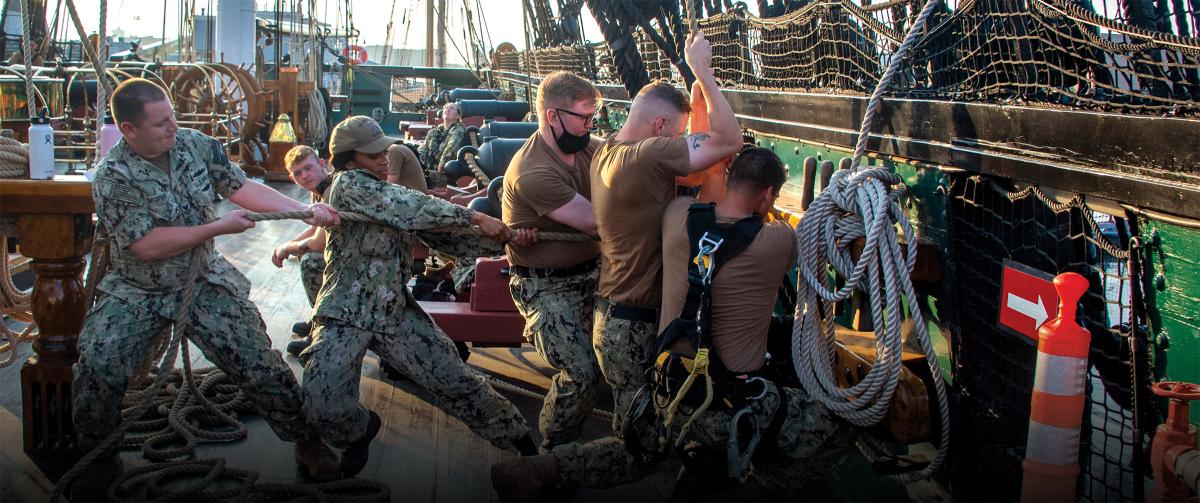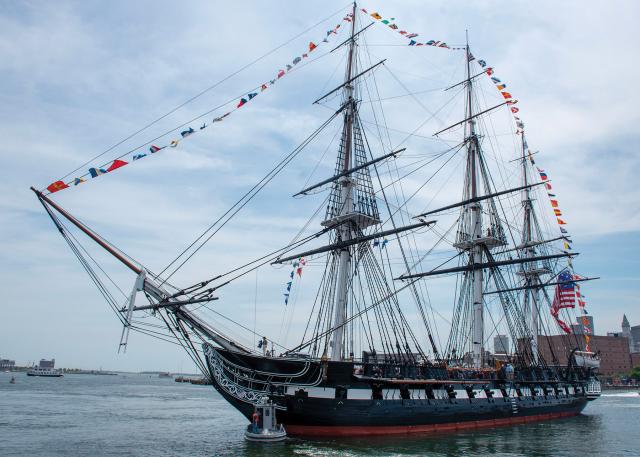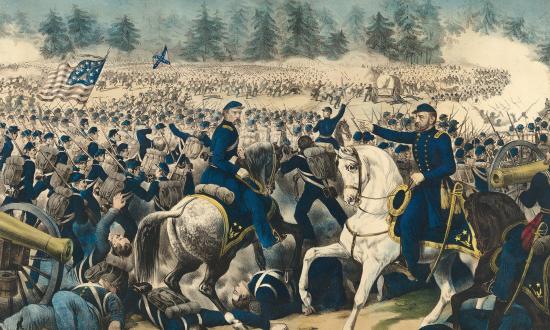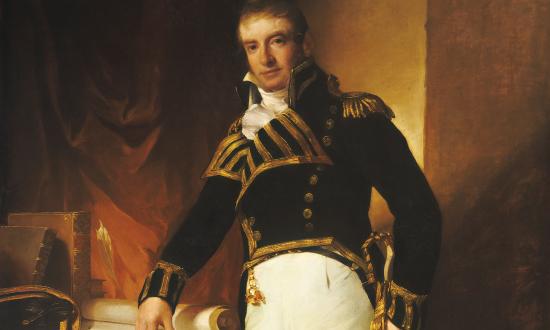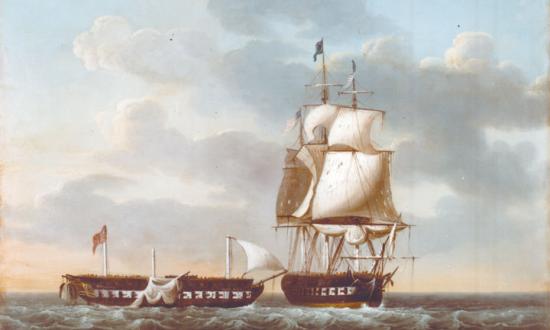In the War of 1812, the USS Constitution and HMS Guerriere engaged in bloody, at-sea combat. The American frigate’s dense live oak hull helped win the day, as British cannonballs bounced harmlessly off her sides. The victory cemented her nickname “Old Ironsides,” and her undefeated record, spanning 33 enemy engagements, guaranteed her status as a legend and national treasure.
More than 200 years later, Old Ironsides’ active-duty sailors share with visitors the thrilling history of the U.S. Navy’s earliest heroes.
But there is a problem.
To say the Constitution represents the heritage of the U.S. Navy alone fails to honor the vast U.S. Marine Corps history that traces directly to the decks of Old Ironsides.
Marines on Board
Returning to the Constitution’s battle with Guerriere, the story is incomplete without mentioning Marine Lieutenant William S. Bush.
In 19th-century naval combat, Marines served as snipers, positioned on platforms high up on ship masts. These sharpshooters could eliminate critical enemy personnel, throwing their opponent’s communication and leadership into chaos. Marines also fought man-to-man, leading boarding parties, and it was in that action that Bush made the ultimate sacrifice. Bush’s junior officer, Marine Second Lieutenant John Contee, tells the story in a letter to Bush’s brother in September 1812:
In the heat of the action the Marines were called aft, led by the illustrious Bush, who, mounting the taffrail, sword in hand, and as he exclaimed “Shall I board her” received the fatal ball in his left cheek bone, which passed through to the back of his head, thus fell that Great and Good officer, who when living was beloved and now gone, is lamented by all. His loss is deeply regretted by his country and friends, but he died as he lived, with honor to both.
Bush was the first Marine officer lost in combat at sea. He was awarded a Silver Medal by Congress, and the Constitution’s quarterdeck is named in his honor. Two U.S. Navy destroyers also would bear his name. Bush understood his duty, writing to a friend before reporting on board:
I am ordered to the Constitution . . . should an opportunity be afforded for boarding the enemy, I will be the first man upon his deck.
Many more Marines shed their blood on the decks of the Constitution before her fighting career concluded. Her exemplary combat record would not have been possible without the bravery and sacrifice of her Marines. During the War of 1812, Old Ironsides defeated three more ships: HMS Java and, during a simultaneous engagement, both HMS Cyane
and Levant.
Captain Charles Stewart employed impressive feats of seamanship to win the two-on-one encounter. Many accounts of the battle focus on these sailing tactics, but Stewart made a point in his after-action report to credit the “lively and well-directed fire” of his Marine marksmen in winning the battle with minimal lives lost—6 Americans compared to 19 British sailors.
The Marine lieutenant who fought alongside Stewart was decorated for gallantry. His name was Archibald Henderson, a name all aspiring Devil Dogs learn in boot camp. Henderson went on to serve in the Marine Corps for a record 52 years, becoming its fifth Commandant and a military legend known as the “Grand Old Man of the Marine Corps.”
The Constitution’s connection to Marine Corps history also can be found in the first line of the Marines’ Hymn: “From the Halls of Montezuma to the shores of Tripoli; We fight our country’s battles in the air, on land, and sea.”
“The shores of Tripoli” refers to the Barbary War (1801–5), when the Constitution served as flagship of the squadron leading the campaign. Marines under First Lieutenant Presley O’Bannon led a nearly 600-mile desert march to capture the city of Derna, Tripoli, as Lieutenant Isaac Hull supported the assault with vessels from the Constitution’s squadron. After the capture of Derna, O’Bannon raised the U.S. flag, the first time the Stars and Stripes flew over an enemy fortress on the other side of the Atlantic.
Sailors and Marines defended U.S. merchants in the Barbary War. During the Quasi-War with France, Marines from the Constitution landed on Puerto Plata to disable a Spanish fort’s guns, effectively completing the U.S. Navy’s first amphibious assault (the Battle of Nassau being an action of the Continental Navy).
A Missed Opportunity
More than 600,000 visitors step onto the decks of Old Ironsides annually. When they return ashore, they typically have gained a deeper understanding of the Navy’s history and a greater appreciation for today’s sailors. The Constitution thus is an ambassador and educator on behalf of the U.S. Navy. The benefits the Navy reaps in public support, recruiting, and pride in service are impossible to fully quantify.
In 2019, Marine General Joseph Dunford, 19th Chairman of the Joint Chiefs of Staff and 36th Commandant of the Marine Corps, held his retirement ceremony in the USS Constitution museum, supported by the ship’s crew (he intended to hold it on board the ship but for the weather). In a subsequent leadership talk, he said the ship is an example of the need for a strong Navy and Marine Corps team. His statement highlights a missed opportunity.
The Constitution falls short when used to promote only the Navy, as her legacy is as one of history’s greatest examples of the power of the Navy–Marine Corps team. Throughout all the events, public outreach, and heritage training, the focus is on the Navy. Marine Corps heritage is an afterthought at best.
Some crew members have gone to great lengths and done considerable research to highlight the Constitution’s Marine Corps heritage. Still, a sailor can only truly represent the Navy. It takes a Marine to represent the Marine Corps.
And it takes both to represent the Navy and Marine Corps team.
Admiral David Dixon Porter reinforced this point in an 1863 letter to Commandant of the Marine Corps Colonel John Harris:
A Ship without Marines is like a garment without buttons.
On 27 March 1794, George Washington signed the Act to Provide a Naval Armament. This act directed the construction of the Navy’s original six frigates, including the Constitution. Washington gave specific instructions that the crew composition include a Marine complement of one sergeant, one corporal, one drum, one fife, and 50 privates. The full crew required to sail, fight, and complete the ship’s mission was nearly 500 people.
Today, the mission has changed, and the crew consists of fewer than 100 sailors, but Marines are no less essential.
The heritage and sacrifice of the Constitution’s Marines demand we return Marines to her crew roster. We have a duty to learn from their example, tell their stories, and inspire future combat leaders. Adding Marines to the modern crew of the Constitution will extend all the benefits this historic vessel provides the Navy to the Marine Corps as well. They will continue to weave Marine Corps heritage into the tapestry of the Constitution’s ongoing story.
When the Navy and Marine Corps operate together, they become a force greater than the sum of their parts. The return of Marines to the Constitution would elevate the ship beyond being a symbol of the Navy or of the Marine Corps—she would be a battle-proven embodiment of the necessity and strength of a unified Navy and Marine Corps team.
Sources
“A Conversation with Leadership” with James Mattis, USS Constitution Museum webinar, 5 March 2012.
Robert Debs Heinl, Soldiers of the Sea: The U.S. Marine Corps, 1775–1962 (Annapolis, MD: Naval Institute Press, 1962).
Tyrone Martin, A Most Fortunate Ship: A Narrative History of Old Ironsides, rev. ed. (Annapolis, MD: Naval Institute Press, 2003).
Allan R. Millet, Semper Fidelis: The History of the United States Marine Corps, rev. and expanded ed. (New York: The Free Press, 1980, 1991).
Ian W. Toll, Six Frigates: The Epic History of the Founding of the U.S. Navy (New York: W. W. Norton & Company, 2006).
A. B. C. Whipple, To the Shores of Tripoli: The Birth of the U.S. Navy and Marines (Annapolis, MD: Naval Institute Press, 2001).
USS Constitution Museum’s Digital Collection



